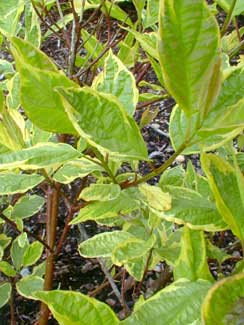
'Spaethii' Golden Variegated
or Yellow-edge
Tartarian Dogwood
"Twig & bough
And blade & thorn
All in an icy
Quiet, forlorn."
-Walter de la Mare
(1873-1958)
(1873-1958)
Cornus alba 'Spaethii' or 'Spaethii Auria' is the Golden Variegated Siberian or Tartarian redtwig dogwood. It has olive-green leaves with golden-yellow edges. Autumn leaf color is purple. It is a recipient of the Award of Garden Merit, for ease of care & reliable performance. There are also white-variegated forms, notably 'Elegantissima' & its semi-dwarf version 'Ivory Halo.'
Mid to late spring's cymes of creamy white flowers seem showier on the non-variegated varieties of Tartarian dogwood; they are more subdued when competing with large colorful leaves. The flowers become white to bluish steel-grey berries in summer, showier than the blooms. If not taken by birds the fruits can linger long after leaf-fall & into winter.
Wine-red upright stems make a great impact for the winter garden. Twig color is best on young limbs. Annual late-winter removal of a fourth of the limbs will insure a good percentage of the twigs will show the best color. But it needs a good percentage of its older limbs, too, in order to flower & fruit.
For its first several years it will be a small to medium-sized & quite compact shrub with strongly upright limbs. But when well-established it can start to spread by suckering, sometimes agressively, & will grow to as high as eight to ten feet, with fountaining limbs. So it's going to need space.
A huge mature specimen can be a glorious shrub, but if it had been planted in an area where its initial restraint & slower growth rate was preferred or counted on, its mature growth spurts can be alarming, especially if the Tartarian dogwood begins to crowd nearby shrubs. The dense root system will prove nigh on impossible to dig up, so placement in the right location from the start is essetial.
Goldleaf Variegated tartarian dogwood is of garden origin. The species is native to Siberia, Manchuria, & North Korea, so it is extremely cold-hardy. Its North American equivalent is Cornus sericea ssp sericea, the American Redtwig. Similarities are so great that the Tartarian's American cousin was formerly classified as a subspecies of C. alba.
Suited for zones 3 through 8, Tartarian dogwoods like full sun but variegated forms can even so be sensitive to summer heat & may need a little protection during the longest hottest days. A big fir tree or the like providing partial shade from the westerly direction would likely be sufficient.
It will adapt to partial shade where it will need less water to thrive & brings brightness to semi-shaded corners. This might be the best option in the Pacific Northwest, as variegated leaves can be especially sun-sensitive given our unusually long sunny exposures at the height of summer; shade is at least a good idea for part of the afternoon. But if too shaded, it might not flower or fruit, & it will get taller & less compact seeking light.
A long-established shrub can be fairly drought-tolerant though it prefers moist well-draining soil. Such fancy cultivars of Tartarian dogwood do not grow true from seeds but are propogated from hardwood cuttings taken late in winter, being easily started in coldframes.